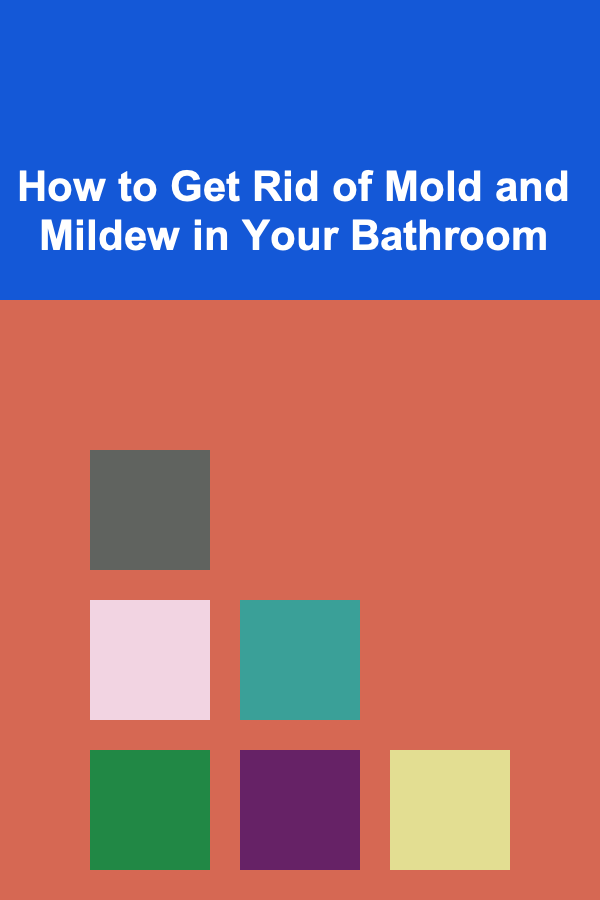
How to Get Rid of Mold and Mildew in Your Bathroom
ebook include PDF & Audio bundle (Micro Guide)
$12.99$9.99
Limited Time Offer! Order within the next:

Mold and mildew are two of the most persistent and common problems found in bathrooms. They thrive in the warm, humid conditions typical of bathrooms, making them a major concern for homeowners. While they are often thought of as merely unsightly, mold and mildew can also be harmful to health and the integrity of your home. Therefore, understanding how to identify, prevent, and eliminate them is essential for maintaining a healthy and clean bathroom.
This guide will explore the causes of mold and mildew, how to identify them, and most importantly, how to get rid of them using both natural and chemical solutions. We will also cover the steps you can take to prevent mold and mildew growth in the future.
What Is Mold and Mildew?
Before we dive into how to deal with mold and mildew, it's important to understand what they are. Mold and mildew are both types of fungi that thrive in moist, warm environments. While they share similarities, there are distinct differences between the two.
Mold
Mold is a type of fungus that can appear in various colors, including black, green, or white. It has a fuzzy or slimy texture and can often cause an unpleasant smell. Mold grows in patches and can spread rapidly, particularly in areas with high humidity. Some types of mold, such as black mold (Stachybotrys chartarum), are toxic and can lead to serious health issues, especially for people with respiratory problems or weakened immune systems.
Mildew
Mildew is another type of fungus, but it typically appears as a powdery or downy substance that is white, gray, or yellow. Unlike mold, mildew does not usually cause the same extent of damage, but it can still lead to health issues, particularly in people with allergies. Mildew tends to develop on surfaces such as bathroom tiles, shower curtains, and walls, and it can be easier to remove than mold, though still requiring attention.
Causes of Mold and Mildew Growth in the Bathroom
Understanding what causes mold and mildew to grow is the first step in preventing their growth and removing them effectively.
High Humidity
Bathrooms are naturally high-humidity environments due to the frequent use of hot water in showers and baths. The steam and moisture in the air create a perfect breeding ground for mold and mildew. Without proper ventilation, this moisture settles on bathroom surfaces, allowing fungi to thrive.
Poor Ventilation
A lack of proper ventilation exacerbates the problem of humidity. Bathrooms without windows or functioning exhaust fans trap moisture in the air. Without airflow, this moisture condenses on walls, ceilings, and other surfaces, leading to mold and mildew growth.
Leaks
Leaks from pipes, sinks, or showers can lead to excess moisture in the bathroom. Even small, unnoticed leaks can create damp conditions in hidden areas, such as behind walls or under flooring, encouraging mold and mildew to grow.
Organic Materials
Mold and mildew feed on organic materials like soap scum, oils, and dirt. These materials can accumulate in bathrooms, providing a food source for fungi. Shower curtains, grout, and bathroom rugs are especially prone to mold and mildew growth.
How to Identify Mold and Mildew in the Bathroom
Mold and mildew can be easy to spot, especially if they've been allowed to grow unchecked. Here are some signs to look out for:
Visual Signs
- Color and Texture: Mold often appears as dark green, black, or brown patches with a fuzzy texture, while mildew tends to be white, gray, or yellow with a powdery or downy appearance.
- Surface Damage: Both mold and mildew can cause staining or discoloration of surfaces. You may notice discoloration on tiles, grout, ceilings, and walls.
- Persistent Musty Smell: A strong musty odor in the bathroom is often a sign of mold or mildew growth. The smell can linger even after cleaning, indicating that mold or mildew may be deeply embedded in surfaces.
Health Symptoms
Mold and mildew can trigger various health issues, particularly for those with respiratory problems or allergies. Symptoms include:
- Sneezing
- Coughing
- Watery or itchy eyes
- Skin irritation
- Breathing difficulties
If you experience these symptoms in your bathroom, it could be a sign that mold or mildew is present.
How to Remove Mold and Mildew from Your Bathroom
Now that we understand the causes and identification of mold and mildew, let's explore the most effective methods for removing them. Both natural and chemical cleaning solutions can be used, depending on your preference.
Natural Cleaning Solutions
For those who prefer eco-friendly and non-toxic options, there are several natural cleaning methods that can effectively eliminate mold and mildew.
1. Vinegar
White vinegar is a natural disinfectant and mold-killer. It can be used to clean and remove both mold and mildew in the bathroom.
Instructions:
- Pour white vinegar into a spray bottle.
- Spray the vinegar directly onto the moldy or mildewed areas.
- Allow the vinegar to sit for about an hour.
- Scrub the affected area with a brush or sponge.
- Rinse the area with water and dry thoroughly.
2. Baking Soda
Baking soda is a gentle yet effective cleaner that can be used to scrub away mold and mildew, especially in areas with grout or textured surfaces.
Instructions:
- Mix one-quarter teaspoon of baking soda with water to form a paste.
- Apply the paste to the moldy or mildewed surface.
- Scrub the area with a brush, focusing on the crevices and hard-to-reach areas.
- Rinse and wipe the surface clean with a damp cloth.
3. Hydrogen Peroxide
Hydrogen peroxide is another natural disinfectant that is effective at killing mold and mildew. It's a great option for light-colored surfaces, as it may have mild bleaching effects.
Instructions:
- Pour 3% hydrogen peroxide into a spray bottle.
- Spray the solution onto the moldy surface.
- Let it sit for 10-15 minutes.
- Scrub the area with a brush or sponge.
- Rinse with water and dry thoroughly.
4. Tea Tree Oil
Tea tree oil has antifungal properties that make it an excellent choice for removing mold and mildew. While it is a more expensive option, it is highly effective and naturally antibacterial.
Instructions:
- Mix one teaspoon of tea tree oil with one cup of water in a spray bottle.
- Spray the solution onto the affected areas.
- Let it sit for an hour before scrubbing.
- Wipe the area clean and dry thoroughly.
Chemical Cleaning Solutions
If natural solutions aren't strong enough for your situation, commercial mold removers can be effective. However, it's important to use these products carefully, as they may contain harsh chemicals.
1. Bleach
Bleach is a powerful mold and mildew killer that can eliminate fungi quickly. It's best for use on non-porous surfaces such as tiles, bathtubs, and sinks. However, bleach can be harmful to both skin and lungs, so it's essential to use it in a well-ventilated area.
Instructions:
- Mix one cup of bleach with one gallon of water.
- Apply the solution to the moldy area using a sponge or cloth.
- Allow the bleach to sit for 10-15 minutes.
- Scrub the area with a brush.
- Rinse thoroughly with water and dry completely.
2. Ammonia
Ammonia is another chemical option that can remove mold and mildew. However, never mix ammonia with bleach, as this can create toxic fumes.
Instructions:
- Mix one part ammonia with one part water.
- Apply the solution to the affected areas using a spray bottle.
- Let the solution sit for 10 minutes.
- Scrub the area with a brush or sponge.
- Rinse with water and dry completely.
Cleaning Hard-to-Reach Areas
Mold and mildew can grow in places that are hard to reach, such as behind shower curtains, in grout lines, or on the ceiling. Here's how to tackle these tricky areas:
- Shower Curtains: Remove the curtain and wash it in hot water with detergent and a cup of vinegar. If it's made of fabric, you may want to consider replacing it if the mildew is severe.
- Grout: Grout lines can harbor mold and mildew, so make sure to scrub them with a toothbrush and cleaning solution.
- Ceiling: Mold can accumulate on bathroom ceilings, especially around ventilation fans. Scrub these areas with a solution of vinegar or hydrogen peroxide to remove the mold.
Preventing Mold and Mildew Growth in the Future
Once you've successfully removed mold and mildew from your bathroom, it's important to take steps to prevent them from returning. Here are some tips to keep your bathroom mold-free:
1. Increase Ventilation
Ensure that your bathroom has proper ventilation to reduce humidity. Install a quality exhaust fan that can effectively remove moisture from the air. If your bathroom doesn't have a fan, consider installing one or opening a window while you shower to allow moisture to escape.
2. Use a Dehumidifier
In bathrooms with high humidity, using a dehumidifier can help to reduce moisture in the air, making it harder for mold and mildew to grow.
3. Fix Leaks Promptly
Regularly check your bathroom for leaks around pipes, sinks, and showers. Address any leaks immediately to prevent excess moisture from building up in hidden areas.
4. Dry the Bathroom After Use
After taking a shower or bath, dry off surfaces with a towel or squeegee to remove excess moisture. Wipe down the walls, mirrors, and any other wet areas to prevent mold and mildew from forming.
5. Clean Regularly
Regular cleaning can help prevent mold and mildew buildup. Use a mild cleaner to wipe down surfaces and remove soap scum, which can provide a food source for fungi.
Conclusion
Mold and mildew are common bathroom problems, but with the right approach, they can be eliminated and prevented. By understanding their causes, knowing how to clean them effectively, and taking preventive measures, you can keep your bathroom fresh and mold-free. Whether you choose natural cleaning solutions or opt for chemical products, regular maintenance and proper ventilation are key to ensuring that your bathroom remains a healthy and pleasant space.
Reading More From Our Other Websites
- [Organization Tip 101] How to Simplify Your Fitness Routine for Better Results
- [Home Party Planning 101] How to Choose the Right Party Games for Your Home Celebration
- [Home Staging 101] How to Stage Your Home for Families with Kids
- [Needle Felting Tip 101] Best Ways to Incorporate LED Lights into Needle‑Felted Art Pieces
- [Skydiving Tip 101] Step-by-Step Guide to a Safe Tandem Skydiving Experience
- [Home Budget 101] How to Save on Home Decor Without Compromising Style
- [Organization Tip 101] How to Create a Relaxation Space That's Tidy and Inviting
- [Personal Financial Planning 101] How to Use the 50/30/20 Rule to Optimize Your Spending
- [Home Renovating 101] How to Install a Backsplash in Your Kitchen
- [Home Staging 101] How to Stage Your Home to Appeal to Millennial Buyers

How to Choose the Best Pet Carrier for Travel Comfort
Read More
How to Choose the Right Moving Supplies for Your Needs
Read More
How to Create DIY Pet Toys and Enrichment Activities
Read More
Smart Ways to Save on Holiday and Seasonal Expenses This Year
Read More
How To Learn a Language on a Budget
Read More
How to Use Meditation to Conquer Your To-Do List Anxiety
Read MoreOther Products

How to Choose the Best Pet Carrier for Travel Comfort
Read More
How to Choose the Right Moving Supplies for Your Needs
Read More
How to Create DIY Pet Toys and Enrichment Activities
Read More
Smart Ways to Save on Holiday and Seasonal Expenses This Year
Read More
How To Learn a Language on a Budget
Read More